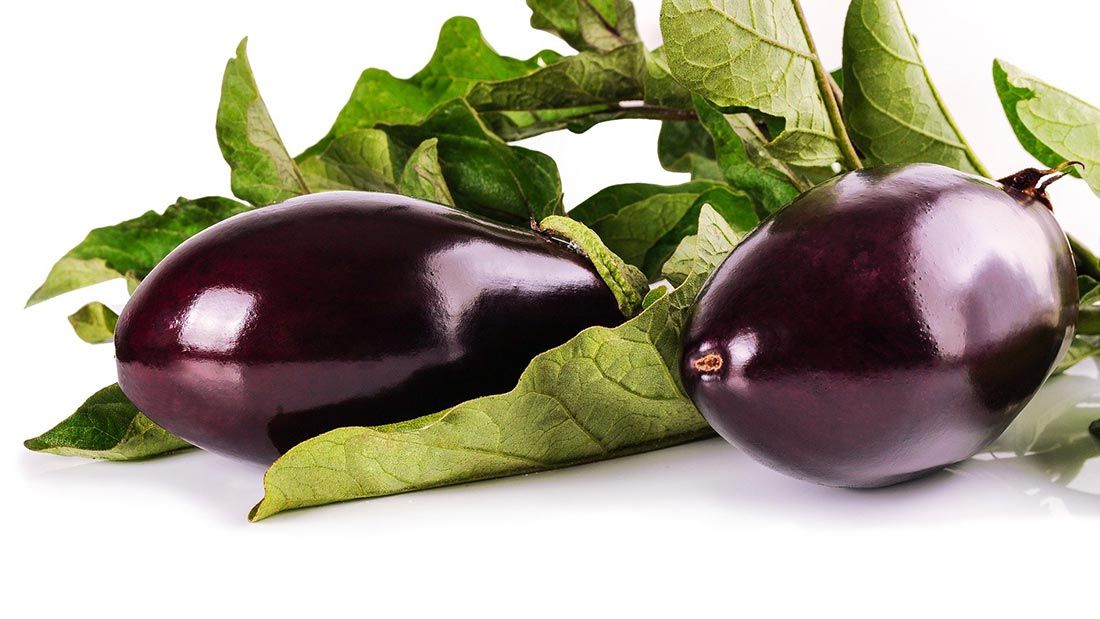Aubergine

This deep purple vegetable popular across the world has a lot to offer.
Aubergine is also known as eggplant or brinjal and belongs to the nightshade family, along with tomatoes and potatoes. It probably originated in India but has been cultivated for millennia and widely used in many Asian and African countries. In Europe, it was first introduced into Spain but spread across the Mediterranean fairly quickly.
There are many varieties of aubergine but the most common by far is the dark purple, elongated one. You also come across white or stripy aubergines but the common one is not just the cheapest, it’s also the heathiest thanks to all the pigments it contains!
- Don’t miss our vegan aubergine recipes on Vegan Recipe Club
Not-so-poisonous beauties
Aubergines contain two types of phytochemicals – one is poisonous, whilst the other one is what gives it the stunning colour and health benefits.
Don’t be alarmed, the poisonous substance, solanine is nothing to worry about. It is present in the whole plant and has pesticidal properties – being a natural insect deterrent defending the plant. In the aubergine itself, the amount of solanine is tiny and you’d have to eat about 36 raw aubergines to suffer any harm. So even if you have an aubergine feast, there’s absolutely no risk!
The pigments that give aubergine skin that ultra-rich, purple-black colour are called anthocyanins. They are powerful antioxidants that help to protect your tissues from damage, the fats in your cells from going rancid and your DNA from being damaged. The darker the colour, the more concentrated are the pigments and the greater the health benefits. It follows that if you peel aubergine, you lose most of these powerful phytochemicals so it’s best to use it whole. Cooking only slightly decreases the amount of anthocyanins in aubergine skin so you’re getting most of the goodness whether you bake or cook it.
The flesh of aubergines contains a range of other important antioxidants so this humble fruit (aubergines are technically fruit) is actually an antioxidant powerhouse! They also contain many vital nutrients but only in small amounts so are not an amazing source of any of them but they do contribute to your daily intake. They are very low in fat and contain a lot of fibre, which means they provide a tasty, low-calorie bulk to your meals – and they absorb flavour like there’s no tomorrow!
Preparation
Raw aubergines can have a bitter taste and sometimes retain it even when cooked. It doesn’t happen often but if you want to be sure it doesn’t, slice and salt the aubergine first, let it sweat and then rinse before using.
As aubergine flesh is quite light and spongey, it absorbs cooking sauces and fats really well, which is a great advantage for achieving delicious flavours but be careful with fat and oil as it can really soak them up.
How to choose and store
Always chose aubergines with a smooth, tight surface that feel heavy for their size. When the skin starts sagging it means they’ve been sitting in the shop too long. And the same goes for the light ones – they’ve lost some water content due to prolonged storage.
Once you bring your aubergine home, keep it in the fridge and if you bought more than you can use up, chop or slice them and freeze. Cooked aubergine also freezes well so if you want to bake a batch and freeze it, there’s no reason not to!
Itchy mouth? You’re not alone!
Allergies are serious and potentially life-threatening conditions but you can also have a very mild form or a sensitivity to aubergine. Research shows that as many as 10% of people experience some symptoms of irritation after eating aubergine – for example itchy mouth or skin.
People who suffer from atopic (skin rash) reactions are genetically more likely to have a reaction to aubergine because it is relatively high in histamines. However, if you love aubergines, don’t let some gentle itchiness get in the way. If it passes within minutes, it’s not dangerous.
Arthritis and psoriasis
Aubergine, along with tomatoes, peppers and potatoes, belongs to the nightshade family. Despite the name, this group of plants is healthy and great for most of us but there have been some reports that it may trigger flare-ups for people with arthritis and psoriasis. Both of these are auto-immune conditions and each person has different sensitivities and triggers. For some people, nightshades may indeed be irritating. However, scientific research does not confirm that there’s a link between arthritis or psoriasis flare-ups and aubergines – or other nightshades.
If you suffer from one of these conditions, there’s no need to avoid nightshades unless you have a suspicion that they have an aggravating effect on your symptoms. If that’s the case, try to cut them out of your diet for two weeks, then reintroduce one type at a time – tomatoes, peppers, aubergines, potatoes. It’s possible you won’t feel any different or you might discover that you’re sensitive to only one of them. Either way, don’t shun nightshades altogether, they have a lot to offer!
For both arthritis and psoriasis symptoms, it’s crucial to consume plenty of fruit and vegetables rich in antioxidants and aubergines pack a good dose!
Aubergines ahoy!
Aubergines have a lot to offer nutritionally and are a delicious ingredient. Some new areas of research also show promising results, such as anti-cancer, anti-diabetes and cholesterol-lowering properties. In time, we will know more but given the high antioxidant and fibre content of this fruit, it’s very likely science will support these claims.
For now, we can simply feast on aubergines and feel good about eating something so healthful!




